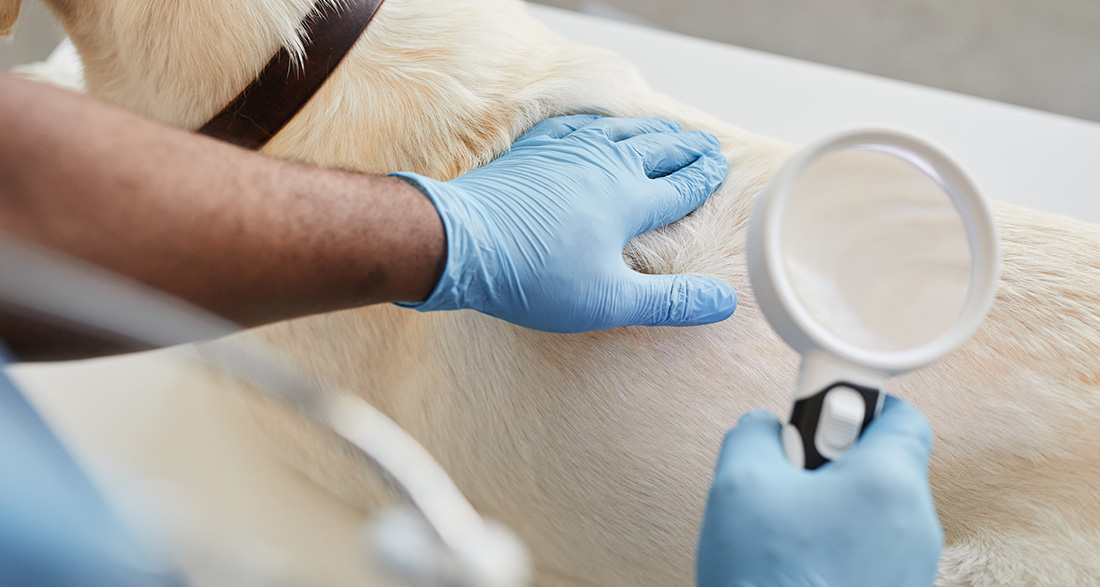Scabies in dogs, also known as Sarcoptic Mange, is a perilous skin condition. Here, we reveal how to recognize this contagious infection and the therapeutic measures available.
Scabies is also referred to as Sarcoptes infection. This parasitic infection is primarily characterized by intense itching and associated skin changes. The itching may manifest locally, confined to specific areas, or affect the entire body, emphasizing the need for swift intervention.
However, intense itching does not always indicate scabies. Food intolerance in dogs can lead to similar symptoms. Therefore, it is crucial to definitively rule out allergies in dogs.
What is Scabies?
Scabies or Sarcoptes in dogs typically manifests through intense itching. The infestation is caused by microscopic mites called scabies mites. The primary culprit is often a specific species of parasite specialized for dogs: Sarcoptes scabiei var. canis. However, scabies mites specialized for foxes can also pose a danger to your beloved pet.
When infested with scabies mites, females create burrows in your dog’s skin to lay their eggs. During their approximately three-week lifespan, a female spider-like mite can lay up to 50 eggs. After a few days, the larvae hatch and, like the mother, feed on keratin and tissue fluid. Male scabies mites die after reproduction.
A dog suffering from scabies can transmit the mites to other dogs while playing and frolicking. If scabies mites, along with skin flakes, fall off, the parasites can survive for about three weeks without a new host. Dogs can also become infected during activities like walking.
Scabies mites do not pose a significant threat to humans as they are specialized for dogs. They do not reproduce in human skin. If you happen to contract them, you might only experience mild symptoms. These symptoms should subside on their own after approximately two to three weeks when the life cycle of the scabies mites concludes.

How Do I Recognize Scabies in Dogs?
Typically, the infestation is evident around the eyes, ears, elbows, abdomen, and ankles of the dog. However, untreated skin problems can spread to other areas. Intense itching prompts your dog to scratch and lick extensively.
Characteristic symptoms of a mite infection in dogs include:
- Redness of your dog’s skin.
- Discovery of pustules, papules (nodules on the skin), and crusts.
- Hair loss. You may notice bald spots in your pet’s coat.
- Dry, scaly skin.
- Scratching, licking, and biting behaviors. Your dog may inadvertently cause self-injuries.
- Weight loss in your furry friend.
- Withdrawal and signs of depression.
If it’s not scabies: Allergies in Dogs
Dogs often react to specific components in their diet with allergic symptoms. Perhaps your four-legged companion is intolerant to gluten or reacts to a particular protein source with intense itching and corresponding skin problems. Chicken and pork, in particular, can lead to intolerances. However, in such cases, your dog is likely to experience additional symptoms such as diarrhea or vomiting.
Switching to an unfamiliar protein source can be beneficial in this situation. Try elk, buffalo, sheep, lamb, or horse. For quick relief from diarrhea, consider using clay for dogs: it absorbs excess water, firming up the stool, and can help balance mineral loss caused by diarrhea in your pet.
If the symptoms subside after a dietary change, your canine friend is likely allergic to a specific protein. Additionally, colorings, additives, lactose, or other supplements can make life difficult for sensitive furry noses.
Our Tip: Recognizing and Treating Scabies in Dogs
If your beloved pet falls into the category of digestion-sensitive animals or suffers from food intolerances and allergies, we recommend choosing species-appropriate food. It should be made from high-quality ingredients, ideally of food-grade quality. The meat content of the food should be as high as possible, complemented by small amounts of high-quality carbohydrates from fruits and vegetables, as well as minerals.
Based on our experience, we can recommend Anifit’s wet food. We appreciate its consistently high-quality composition, with a meat content ranging from 90 to 99%. This makes the food species-appropriate, as dogs, being omnivores, primarily need animal protein.
Selected carbohydrates complement the recipes, and the food is free from sugar, colorings, additives, gluten, corn, soy, as well as cereals and plant flours. It’s best to see if your furry friend benefits from it. You can order a trial package with various flavors here, with portion sizes ranging from 200g to 810g.
Diagnosis & Therapy: How is Scabies Detected and Treated in Dogs?
If you suspect that your four-legged companion is suffering from scabies mites, a visit to the vet is necessary. The vet will examine whether your furry friend’s skin problems are genuinely caused by scabies mites or other factors, such as allergies that can also trigger severe itching. Your vet may take a skin sample to examine it for adult burrowing mites, as well as eggs, larvae, nymphs, and mite feces.
An additional blood test can confirm the diagnosis of “scabies in dogs.” However, it takes at least 14 days for antibodies to develop. Another challenge is that not every affected dog develops antibodies against scabies mites, making a secure diagnosis difficult. Your vet may treat your furball based on suspicion. If the symptoms subside following the therapy, it confirms the diagnosis.
Various options are available for treating this parasitic infection:
- Spot-ons: These are applied to the neck of the affected host and contain the active ingredients Selamectin or Moxidectin.
- Injections: A shot of Ivermectin is also an effective remedy against scabies mites.
- Special Shampoo: Alternatively, you can wash or bathe your dog using Amitraz.
If your pet suffers from particularly severe itching, your vet may recommend additional treatment with glucocorticoids to alleviate the symptoms. Clay for dogs can also soothe stressed skin. The treatment must continue until all scabies mites are completely eradicated.
If you have several dogs in your household, it’s advisable to treat them simultaneously. Scabies is highly contagious. In addition to medication, a thorough cleaning of all sleeping areas and food bowls is necessary. If your dog snuggles against your legs or you cuddle intensively with him, it’s also advisable to wash your clothes after contact.

Mites in Dogs: How Can I Prevent Scabies?
Complete prevention of your dog’s infection with scabies mites is not possible. This is because your furry companion encounters fellow animals while outdoors. Transmission can occur quickly during sniffing, playing, and frolicking. Moreover, the parasites can survive in the environment. Therefore, there is a risk of mite contact during every walk. However, you can at least recognize infection with Sarcoptes scabiei var. canis early and take prompt action:
- Regularly clean your dog’s sleeping areas and food and water bowls.
- Prevent contact between your dog and strays, as well as wild animals such as foxes and rabbits.
- Assist your furry friend with grooming. Clean combs and brushes afterward.
- Additionally, it’s advisable to check for skin changes or itching after every walk. While this doesn’t prevent scabies mite infestation, it ensures that your pet receives help quickly.
Conclusion
Scabies is a common and fortunately treatable condition in dogs. However, the distressing itching can have different causes, and not every case is attributed to parasitic burrowing mites. Your vet will help determine whether your dog may be suffering from food intolerances and allergies or whether there is indeed an infestation with these tiny parasites.


